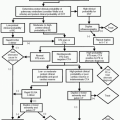Stridor and Wheezing
David A. Weiland
Definition and General Workup.
Inspiratory stridor is defined as noisy breathing due to turbulent airflow through a partial upper airway obstruction (above the thoracic inlet). The most common causes of stridor in children include croup, epiglottis, and foreign body aspiration. Evaluation of inspiratory stridor should include anteroposterior (AP) and lateral soft tissue radiographs of the neck including the upper airway. If the cause of stridor is not evident from the radiographs, computed tomographic (CT) findings can identify the exact level of obstruction, and can oftentimes provide clues to the specific diagnosis.
Croup
Clinical Information
Croup affects children 6 months to 3 years of age. The patient typically presents with a characteristic “brassy, barking” cough. Hoarseness and inspiratory stridor are also common, and there is usually a history of a recent lower respiratory tract infection.
Etiology.
It is classically associated with the parainfluenza virus, but influenza and respiratory syncytial virus (RSV) can both cause an identical clinical presentation. The tracheal mucosa is loosely attached to the upper trachea. Inflammation and edema elevate the mucosa, which leads to narrowing just below the larynx. External restriction by the cricoid cartilage or complete tracheal cartilaginous rings can worsen the obstruction.
Radiography.
Given the correct clinical scenario, diagnosis is possible on AP and lateral radiographs of the upper airway (Fig. 18-1). The classic “steeple sign,” seen on the AP view, represents symmetric subglottic narrowing. There is loss of the normal “shouldering” of the air column. The “steeple sign” is accentuated in expiration. The subglottic trachea is narrowed and indistinct on the lateral view; the epiglottis and aryepiglottic folds are normal.
Differential Diagnosis.
The aim of radiology in diagnosing croup is to exclude other causes of inspiratory stridor such as congenital or acquired subglottic stenosis, foreign body aspiration, epiglottitis, and subglottic hemangioma.
Epiglottitis
Clinical Information
The peak incidence of epiglottitis occurs in children 3-6 years old, who present with the abrupt onset of inspiratory stridor and severe dysphagia. The patient is usually febrile and appears ill. The classic description is that of a drooling patient who is sitting up and leaning forward in an effort to splint open the upper airway. The incidence of epiglottitis has become less frequent with the widespread immunization of children with the Hemophilus influenza type B (Hib) vaccine.
Stay updated, free articles. Join our Telegram channel

Full access? Get Clinical Tree



